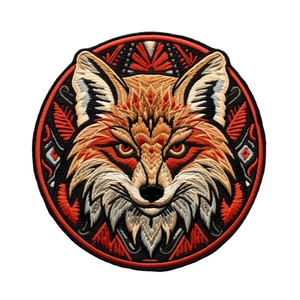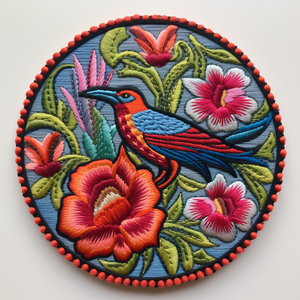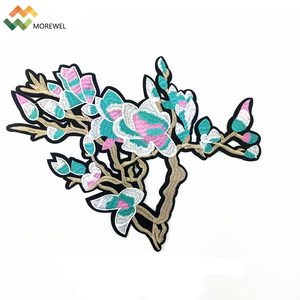Types of hand work embroidery designs
Embroidery design hand work can be categorized into several types depending on the stitches and techniques used. Here are some of their types:
-
Freehand embroidery
It involves stitching patterns directly onto the fabric without any prior marking or guide. This technique allows for spontaneous and creative expression, resulting in unique and one-of-a-kind designs. It is used for both decorative and artistic purposes, and requires a steady hand and an eye for detail, as there are no markings to guide the embroiderer.
-
Counted cross stitch
This type of hand-stitched embroidery work involves counting the threads in the fabric to create a grid. Each X-shaped stitch covers one square of the grid, forming a distinctive pixelated appearance. It is commonly used for creating intricate patterns, designs, and images, often resulting in a tapestry-like effect. This technique is popular for its ease of use and ability to create detailed, symmetrical designs.
-
Appliqué embroidery
It involves stitching a smaller piece of fabric onto a larger one to create a pattern or design. The edges of the appliqué piece are typically secured with stitches to prevent fraying and to attach it firmly to the base fabric. Embroidery is then used to add decorative elements, such as flowers, motifs, or detailed stitching, enhancing the overall design. This technique is widely used in quilting, garment making, and home décor.
-
Embroidery patch work
This technique involves creating small, embroidered patches that can be appliquéd onto a base fabric. Each patch is a self-contained design, often representing a specific motif, symbol, or image. The patches can be made using various embroidery techniques, such as satin stitch, appliqué, or cross stitch. Once the patches are completed, they are sewn or glued onto the larger fabric piece, creating a collage-like effect. This method offers versatility and allows for easy customization and replacement of individual patches.
-
Quilted embroidery
It combines the techniques of quilting and embroidery to create a textured, layered fabric. In this method, the layers of fabric are stitched together in a quilted pattern, often using a series of lines or shapes to create a padded, raised effect. After the quilting is complete, embroidery is added to embellish the surface with intricate designs, motifs, or text. This technique is commonly used for making quilts, cushions, and other home décor items, resulting in a tactile and visually appealing finish.
Design of hand work embroidery
Hand embroidery is a skillful process of decorating fabric with needle and thread alone. The hand-stitched designs are one of a kind and can be made as planned or as spontaneous as an artist's painting. Hand work embroidery requires basic materials like fabric, thread, needle, and an idea.
Hand-stitched embroidery designs depend on the skill of the embroiderer. There are various stitches; some are very simple, while others are very complex. The thread can be any color or type, and the fabric can be any kind of material.
Hand-stitched embroidery designs are often floral, but they can also be geometric or abstract. Some designs are small and simple, while others are large and detailed. Hand work embroidery can be done on clothes, linens, towels, and many other fabrics.
Hand-stitched embroidery is a slow and meditative process. It requires patience and concentration. But the result is a beautiful and unique piece of art that is made with love.
- Floral Embroidery: Floral patterns are timeless and can range from simple blossoms to intricate bouquets. These patterns are often inspired by nature and can be adapted to include specific flowers or arrangements that hold personal significance. For instance, a favorite flower or one that symbolizes a particular memory can be central to the design. Floral embroidery is versatile, suitable for decorating everything from clothing to home textiles like cushions and wall hangings.
- Geometric Shapes: Geometric embroidery utilizes shapes like triangles, circles, and hexagons to create modern and abstract designs. These patterns can be repetitive, forming a tessellating effect, or singular, focusing on a specific geometric shape. Geometric embroidery is often used in minimalist designs, appealing to those who prefer a clean, contemporary aesthetic. It can be incorporated into clothing, accessories, and home decor items for a sleek, modern look.
- Nature-Inspired Designs: Beyond floral patterns, nature-inspired embroidery can include elements like leaves, trees, mountains, and animals. These designs often capture the beauty of the natural world and can be very detailed, showcasing the intricacies of various natural forms. For example, a design featuring a favorite tree or mountain range can evoke a sense of place and memory. Nature-inspired embroidery is popular for outdoor enthusiasts and can be used in a wide range of projects, from clothing to wall art.
- Abstract Art: Abstract art embroidery allows for a freeform approach, using color, shape, and texture to create non-representational designs. These patterns can be inspired by modern art movements, incorporating elements from famous artists' works or purely abstract concepts. The result is a unique, one-of-a-kind design that reflects the embroiderer's artistic vision. Abstract art embroidery is suitable for those who enjoy experimenting with color and form, making it ideal for creating distinctive clothing and decor items.
- Sentimental Quotes: Hand-stitched embroidery is also a beautiful way to incorporate meaningful quotes, lyrics, or phrases into a design. These patterns can be customized to include specific text, often using decorative lettering techniques to make the words stand out. Sentimental quotes embroidery is perfect for creating personalized gifts or memorial pieces, allowing one to cherish and commemorate special words and messages.
Wearing/Matching suggestions of embroidery design hand work
- Traditional and Cultural Attire: Hand-stitched embroidery is commonly integrated into traditional and cultural clothes worldwide. For instance, in Indian sarees or Punjabi suits, intricate hand embroidery is a sign of craftsmanship and cultural heritage. Wearing such embroidered attire on festivals or cultural activities honors one's background and displays the artistic skill of the workers. Similarly, in Mexican folk dresses, hand embroidery is bright and symbolic, representing different regions and customs. Matching these clothes with traditional jewelry and accessories enhances the overall look and respects the cultural significance.
- Casual and Bohemian Style: Hand-embroidered denim jackets, jeans, or tops are ideal for casual and bohemian styles. The embroidery adds a unique and artistic touch to the clothing, making it stand out. For instance, a hand-stitched floral design on a denim jacket can be paired with a simple white t-shirt and black jeans for a casual, laid-back look. Similarly, a hand-embroidered top can be matched with flowy skirts or culottes for a bohemian-inspired outfit. Layering with other hand-stitched accessories like bags or scarves can further enhance the boho vibe.
- Formal and Elegant Occasions: Hand-stitched embroidery can elevate the attire for formal events like weddings, parties, or gala dinners. Embroidered gowns, dresses, or suits with intricate and delicate embroidery are stunning and sophisticated. For example, a hand-embroidered evening gown with floral or lace patterns can be complemented with statement jewelry and high heels for a glamorous look. Similarly, a hand-embroidered suit can be paired with a crisp white shirt and tailored trousers for a refined and elegant appearance. The key is to balance the embroidery with other elements to ensure the overall look is cohesive and harmonious.
- Everyday Wear and Accessories: Hand-stitched embroidery is not just limited to clothing; it is also prevalent in accessories like bags, hats, and shoes. Embroidered accessories can add a pop of color and texture to everyday outfits. For instance, a hand-embroidered bag or tote can be matched with a simple jeans and t-shirt outfit to add a touch of artistry and uniqueness. Similarly, embroidered shoes or sandals can enhance the overall look of a casual outfit. The versatility of hand-stitched embroidery allows it to be incorporated into various styles and settings, making it a valuable addition to any wardrobe.
- Layering and Mixing Textures: One of the exciting aspects of hand-stitched embroidery is its ability to be layered and mixed with different textures and fabrics. For example, an embroidered jacket or cardigan can be layered over a simple dress or jumpsuit, adding depth and dimension to the outfit. Similarly, combining embroidered pieces with other textures like lace, silk, or velvet can create a rich and tactile experience. Layering also allows for versatility, as different combinations can be created for various occasions and moods.
Q&A
Q1: What is hand embroidery design, and how is it different from machine embroidery?
A1: Hand embroidery design involves creating patterns and images on fabric using needle and thread techniques. Unlike machine embroidery, which uses automated processes to produce embroidered designs, hand embroidery is a manual craft that allows for greater artistic expression and attention to detail. Each stitch is made by hand, resulting in a unique and personalized embroidered design.
Q2: What are some common stitches used in hand embroidery?
A2: There are many stitches used in hand embroidery, each with its unique characteristics. Some common ones include:
- Backstitch: Creates a solid line and is often used for outlining and creating text.
- Satin Stitch: Fills areas with smooth, solid coverage and is ideal for creating shapes and motifs.
- French Knot: Adds texture and dimension, often used for creating small dots or flowers.
- Chain Stitch: Forms a series of connected loops, suitable for outlining and creating decorative borders.
- Split Stitch: Creates a flexible line and is commonly used for outlining and filling.
Q3: Can hand embroidery be done on any type of fabric?
A3: Hand embroidery can be performed on various fabrics, including cotton, linen, silk, and canvas. Each fabric type has its unique characteristics and suitability for different embroidery projects. For example, cotton and linen are popular choices for beginners due to their ease of use and versatility. Silk adds a luxurious touch to embroidered designs, while canvas is ideal for larger projects and home decor items.
Q4: How can one learn hand embroidery techniques and improve their skills?
A4: Learning hand embroidery techniques can be done through various resources such as books, online tutorials, and embroidery workshops. Practicing different stitches regularly and working on small projects helps build skills and confidence. Joining embroidery communities and forums allows for sharing experiences, seeking advice, and gaining inspiration from fellow embroidery enthusiasts.














































 Ready to Ship
Ready to Ship









































































































































